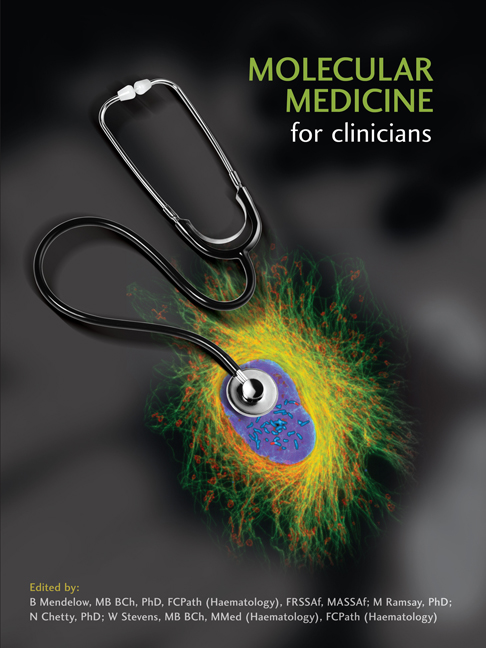Book contents
- Frontmatter
- Contents
- Foreword
- Acknowledgements
- Chapter 1 Introduction
- Keynote Essay 1: Defining Who We Are: DNA in Forensics, Genealogy and Human Origins
- Section 1 Principles Of Cellular And Molecular Biology
- SECTION 2 MOLECULAR PATHOLOGY
- SECTION 3 MOLECULAR THERAPEUTICS
- Chapter 32 Targets for Molecular Therapy: The Biology of Haemostasis
- Chapter 33 Cellular Targets of Antiplatelet Agents
- Chapter 34 Rational Drug Design
- Chapter 35 Chronic Myeloid Leukaemia
- Chapter 36 Gene Therapy
- Chapter 37 Diabetes Mellitus
- Chapter 38 Pharmacogenetics
- Chapter 39 Basic Molecular Biology of Blood Groups
- Keynote Essay 6: Molecular Research Case Study: Developing Novel RNA Interference-based Therapy
- SECTION 4 RESEARCH AND THE CONTINUING EVOLUTION OF MOLECULAR MEDICINE
- Glossary
- Contributors’ Biographies
- Source Material And Recommended Reading
- Permissions And Credits
- Index
Chapter 35 - Chronic Myeloid Leukaemia
from SECTION 3 - MOLECULAR THERAPEUTICS
Published online by Cambridge University Press: 04 June 2019
- Frontmatter
- Contents
- Foreword
- Acknowledgements
- Chapter 1 Introduction
- Keynote Essay 1: Defining Who We Are: DNA in Forensics, Genealogy and Human Origins
- Section 1 Principles Of Cellular And Molecular Biology
- SECTION 2 MOLECULAR PATHOLOGY
- SECTION 3 MOLECULAR THERAPEUTICS
- Chapter 32 Targets for Molecular Therapy: The Biology of Haemostasis
- Chapter 33 Cellular Targets of Antiplatelet Agents
- Chapter 34 Rational Drug Design
- Chapter 35 Chronic Myeloid Leukaemia
- Chapter 36 Gene Therapy
- Chapter 37 Diabetes Mellitus
- Chapter 38 Pharmacogenetics
- Chapter 39 Basic Molecular Biology of Blood Groups
- Keynote Essay 6: Molecular Research Case Study: Developing Novel RNA Interference-based Therapy
- SECTION 4 RESEARCH AND THE CONTINUING EVOLUTION OF MOLECULAR MEDICINE
- Glossary
- Contributors’ Biographies
- Source Material And Recommended Reading
- Permissions And Credits
- Index
Summary
INTRODUCTION
The question may be asked: why discuss therapy of chronic myeloid leukaemia (CML), a relatively rare condition that mainly affects people beyond the fifth decade? The answer is simple; CML is the first cancer found to be associated with a genetic defect the product of which is a protein with oncogenic properties, exclusively confined to the cancer cells. The knowledge gained from this information stimulated additional investigations on other cancers. It also raised the possibility of an alternative approach to cancer treatment by specifically targeting the molecular defect.
CML is cancer of the white blood cells of the bone marrow. It is a unique disease because it is the first cancer found to have a specific genetic defect, the Philadelphia (Ph) chromosome, which is associated with the production of an oncogene, BCR-ABL, the causative agent of the leukaemia. To appreciate therapy for CML, it is necessary to understand the cytogenetic changes that occur and the resultant molecular defect associated with the malignant phenotype of the cell.
CYTOGENETICS
The Ph chromosome, an acquired genetic abnormality, uniquely characterises leukaemic cells in CML. The Ph chromosome, a remnant of chromosome 22 and a portion of chromo - some 9, results from an unequal translocation between the long arms of chromosome 9 and chromosome 22, as depicted in Chapter 22.
In 1984/85 two genes involved in the trans location were identified, the Abelson proto-oncogene (ABL) located on chromo - some 9 and the breakpoint cluster region (BCR) on chromosome 22. The translocation results in the two genes being placed adjacent to each other on the Ph chromosome to produce a fusion or chimeric (chimera – derived from two parts of different origin) gene BCR-ABL. Two different fusion genes may arise. On the derivative 22q– is BCR-ABL, the fusion gene responsible for development of CML, and ABL-BCR is on 9q+ The latter fusion gene is not believed to have clinical significance.
- Type
- Chapter
- Information
- Molecular Medicine for Clinicians , pp. 405 - 412Publisher: Wits University PressPrint publication year: 2008



